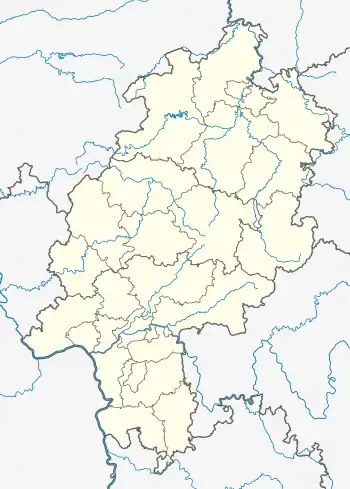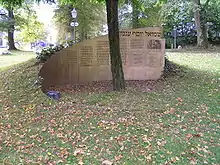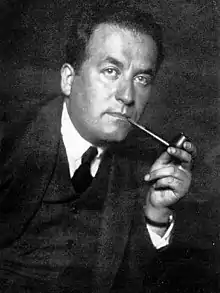Bad Homburg vor der Höhe
Bad Homburg vor der Höhe (pronounced [baːt ˈhɔmbʊʁk] (![]() listen)) is the district town of the Hochtaunuskreis, Hesse, Germany, on the southern slope of the Taunus mountains. Bad Homburg is part of the Frankfurt Rhein-Main urban area. The town's formal name is Bad Homburg vor der Höhe (translated as "Bad Homburg before the Height") to distinguish it from other places named Homburg. The name is abbreviated as Bad Homburg v. d. Höhe.[2] It is known best for its medically used mineral waters and spa (hence the prefix Bad, meaning "bath"), and for its casino.
listen)) is the district town of the Hochtaunuskreis, Hesse, Germany, on the southern slope of the Taunus mountains. Bad Homburg is part of the Frankfurt Rhein-Main urban area. The town's formal name is Bad Homburg vor der Höhe (translated as "Bad Homburg before the Height") to distinguish it from other places named Homburg. The name is abbreviated as Bad Homburg v. d. Höhe.[2] It is known best for its medically used mineral waters and spa (hence the prefix Bad, meaning "bath"), and for its casino.
Bad Homburg v. d. Höhe | |
|---|---|
 Emperor Wilhelm's Spa in Bad Homburg | |
 Coat of arms | |
Location of Bad Homburg v. d. Höhe within Hochtaunuskreis district  | |
 Bad Homburg v. d. Höhe  Bad Homburg v. d. Höhe | |
| Coordinates: 50°13′0″N 8°36′0″E | |
| Country | Germany |
| State | Hesse |
| Admin. region | Darmstadt |
| District | Hochtaunuskreis |
| Government | |
| • Mayor | Alexander Hetjes (CDU) |
| Area | |
| • Total | 51.17 km2 (19.76 sq mi) |
| Highest elevation | 250 m (820 ft) |
| Lowest elevation | 137 m (449 ft) |
| Population (2019-12-31)[1] | |
| • Total | 54,227 |
| • Density | 1,100/km2 (2,700/sq mi) |
| Time zone | UTC+01:00 (CET) |
| • Summer (DST) | UTC+02:00 (CEST) |
| Postal codes | 61348, 61350, 61352 |
| Dialling codes | 06172 |
| Vehicle registration | HG, USI |
| Website | www |
Presently, Bad Homburg is one of the wealthiest towns in Germany (with the Hochtaunuskreis and the Landkreis Starnberg regularly competing for the title of the wealthiest district in Germany).[3] As of 2004, the town's marketing slogan is Champagnerluft und Tradition (Champagne air and tradition).[4]
History
Middle Ages origins
Local tradition holds that Bad Homburg's documented history began with the mention of the Villa Tidenheim in the Lorsch codex, associated with the year 782. This Villa Tidenheim was equated with the Old Town, named "Dietigheim". Local historian Rüdiger Kurth doubted this traditional story based on his study of written sources and local factors. During 2002 Kurth initiated archaeological excavations, by the University of Frankfurt, managed by Professor Joachim Henning. The excavations showed that there was not any evidence of settlement between the beginning of the Christian Era and the 13th century. It seems that the historical record which mentions Wortwin (or Ortwin) von Hohenberch as Homburg's founder, as a documentary witness in Eberbach, about 1180 is the first good evidence of the town's existence.






As early as 1962, in an excavation under the Hirschgangflügel ("Hart-stalking-wing") of Bad Homburg's Schloss (stately home), two burnt layers were discovered, which the man conducting the dig, Günther Binding, accepted as evidence of two former castles having been built on the site, one after the other, but each having burnt down later.
Further digs by the University of Frankfurt at Bad Homburg's Schloss during April 2006, once again initiated by Kurth and managed by Professor Henning, resulted in the discovery that it was actually only one burnt layer, from a half-timbered building—- possibly a castle with towers—- which from ceramic finds could be dated to the 12th or 13th century. Most likely this building had an association with Wortwin's "castle". Quite possibly, though, a further cultural layer from an even earlier time lies underneath these remains. Investigations using methods from natural science (carbon-14 dating and micromorphological analysis) will show whether the dating can be made more precise.
Homberg acquired market rights about 1330, but the document granting these rights is said to have been lost.
The town's name, "Homburg", is from the Hohenberg Castle. The postfix "vor der Höhe" was probably first recorded in a document of 1399. The designation "Bad" was not conferred until 1912.
The Hessen-Homburg noble family of landgraves was initiated by Friedrich I of Hessen-Homburg. Friedrich II (1680–1708) attained fame as Prince of Homburg. During 1866, as a result of the Austro-Prussian War, Homburg became Prussian territory.
Spa town and imperial residence
With the beginning of the spa industry in the town during the mid-19th century, which profited greatly from its casino, the town became an internationally famous spa town. Bad Homburg was favoured particularly by Russian nobility for its baths.
The spa industry began with the discovery of the Elisabethenbrunnen (Brunnen is German for "well") during 1834. The first spa building and the first casino in Homburg were built during 1841–1842 by the brothers François (1806–1877) and Louis Blanc (1806–1852), who later owned the Monte Carlo Casino. During 1860, the town was connected with Frankfurt by a railway line, the Homburger Bahn.
During 1888, Homburg became known throughout the German Empire because Kaiser Wilhelm II declared Homburg's Schloss an Imperial summer residence, and later financed the building of the Church of the Redeemer (Erlöserkirche) nearby. His mother, too, lived there for several years. Edward VII of the UK was also often a guest. It was he who introduced the Homburg hat and permanent turn-up trousers. He also experienced fasting cures at Homburg 32 times.
The "Bad Homburger Golf Club 1899 e. V." in the Röderweisen in Dornholzhausen—nowadays part of Bad Homburg—- is Germany's oldest golf club. It had its beginnings in the Bad Homburg Spa Park (Kurpark), where the old clubhouse and even playable parts of the old golf course may still be found.
Not far away stands the Russian Chapel—- more properly called All Hallows' Church—- an Eastern Orthodox church the first stone of which was laid in the Russian Imperial couple's presence on 16 October 1896, although they did not attend when it was consecrated almost three years later.
King Chulalongkorn of Siam (Thailand) sent a Thai garden pavilion in gratitude for a successful cure. It was erected during 1914.
Horex was a well known German motorcycle brand of the "Horex—Fahrzeugbau AG", founded during 1923 in Bad Homburg by Fritz Kleemann.
Jewish history

During 1335, permission was given by Emperor Louis IV to Gottfried von Eppstein to settle 10 Jews in each of the localities of Eppstein, Homburg, and Steinheim; it is uncertain, however, whether any Jews settled in Homburg at that time. Evidence for the existence of a permanent Jewish settlement in Homburg is found only at the beginning of the 16th century. Until 1600 it consisted of 2 or 3 families, and by 1632 these had increased to 16. The first Jewish cemetery was purchased during the 17th century. The community continued to grow so rapidly that during 1703 the landgrave Frederick II of Hesse decided on the construction of a special Judengasse (Jewish quarter). A synagogue, built during 1731, was replaced by a new one during 1867. The Jewish community of Homburg was originally part of the jurisdiction of the rabbinate of Friedberg but began to appoint its own rabbis during the 19th century.
A Hebrew printing house was located in Homburg by Seligmann ben Hirz Reis during 1710 until 1713 when he relocated to Offenbach am Main. Among other items, he published Jacob ibn Ḥabib's Ein Ya'akov (1712). Hebrew printing was resumed there during 1724 by Samson ben Salman Hanau but lack of capital limited his output. The press was acquired during 1736 by Aaron ben Ẓevi Dessau whose publications included the Shulhan Arukh (Ḥoshen Mishpat) with commentary (1742). The press was sold during 1748 and transferred during 1749 to Roedelheim. At the beginning of the 20th century, the spa of Homburg became a meeting place of Russian-Jewish intellectuals. The Jewish population numbered 604 (7.14% of the total population) during 1865, declining to 379 in 1910 (2.64%), and 300 during 1933. Of the 74 Jews who remained on 17 May 1939, 42 were deported during 1942/1943.[5]
Modern age
While the spa business experienced a long-term decrease after the two world wars, the town gained importance by becoming the site for headquarters of various authorities and administrative bodies. By autumn 1946, the military government had already ordered the founding of bizonal authorities. Bad Homburg was chosen as the seat of the financial administrative centre. On 23 July 1947, the Bizone Economic Council instituted the "Special Money and Credit Centre" here in preparation for currency reform. The centre was managed by Ludwig Erhard. After the Federal Republic of Germany—- West Germany—- was founded with its capital in Bonn, the Federal Debt Administration (Bundesschuldenverwaltung), the Office for Security Adjustment (Amt für Wertpapierbereinigung) and the Federal Equalization Office (Bundesausgleichsamt) stayed in Bad Homburg.
During the 20th century, Bad Homburg became a favourite residential area among the upper classes. On 30 November 1989, one of its members, Alfred Herrhausen, the manager of the Deutsche Bank, was killed and his driver was injured by a car bomb in Bad Homburg. It is alleged that this was an attack by the Red Army Faction, though this has never been proven.[6]
Lord Mayors
- Karl Tettenborn — 1892–1901
- Ernst Ritter von Marx — 1901–1905
- Konrad Maß — 1905–1907
- Walter Lübke DVP 1907–1924
- Georg Eberlein DVP 1924–1933
- Richard Hardt NSDAP 1933–1934
- Erich Meusel NSDAP 1933–1945
- Georg Eberlein FDP, 1945–1948
- Karl Horn CDU, 1948–1962
- Armin Klein CDU, 1962–1980, since 1979 with official designation Lord Mayor
- Wolfgang Assmann CDU, 1980–1998
- Reinhard Wolters CDU, 1998–2003 Lord Mayor; His election was subsequently declared invalid, Wolters was thus never officially Lord Mayor. However, the decisions made by him remained in force.
- Ursula Jungherr CDU, 2003–2009
- Michael Korwisi, Alliance '90/The Greens, 2009–2015
- Alexander Hetjes CDU, since 18. September 2015
Coat of arms
Bad Homburg's civic coat of arms was granted during 1903 but is said to date from the 15th century on the basis of seals known from that time, although they show a saltire rather than the two adzes seen today (the saltire might be two unclear adzes). The reason for the adzes in the arms is not known; it is possibly dialectal canting. The colours, with silver adzes in a blue field, have been in use at least since 1621.[7]
Schools
- Kaiserin-Friedrich-Gymnasium
- Humboldtschule
- Gesamtschule am Gluckenstein
- Maria-Ward-Schule
- Feldbergschule (branch Bad Homburg)
Notable People



early times
- Frederick II, Landgrave of Hesse-Homburg (1633–1708) successful and experienced general, eponymous hero of The Prince of Homburg
- Friedrich Ludwig Abresch (1699–1782), Dutch philologist
- Isaac von Sinclair (1775–1815) writer, diplomat and friend of the poet Friedrich Hölderlin
- Ferdinand, Landgrave of Hesse-Homburg (1783–1866) nobleman, last landgrave of Hesse-Homburg
- Princess Maria Anna of Hesse-Homburg (1785–1846) noblewoman, acted as the first lady of Prussia from 1810 to 1840.
19th c.
- Károly Lotz (1833–1904), German-Hungarian painter
- Louis Jacobi (1836–1910) architect and archaeologist, notable for his dig in Pompeii in 1889
- Karl Wilhelm von Meister (1863–1935), German politician and diplomat
- Heinrich Jacobi (1866–1946) architect and archaeologist of the Roman Empire, son of Louis Jacobi
- Fritz von Loßberg (1868–1942) colonel, and later general, of WW1, a strategic defence planner
- Ludwig von Salm-Hoogstraeten (1885–1944) controversial Austrian tennis player, competed in the 1912 Summer Olympics
- Rudolf von Eschwege (1895–1917), a fighter pilot in WW1, operating on the Macedonian front
- Shmuel Yosef Agnon (1888–1970), Nobel Prize-winning author (1966 together with Nelly Sachs)
20th c.
- Walter Eckhardt (1906–1994) lawyer and local, national and Euro politician
- Tilly Lauenstein (1916–2002), stage and film actress [8]
- Heinz Schmidt (1920–1943), German Luftwaffe officer
- Judith Hemmendinger (born 1923) German-born Israeli researcher and author specializing in child survivors of the Holocaust
- Johanna Quandt (1926–2015), very wealthy business woman, major shareholder of BMW
- Wolfgang Strödter (born 1948), field hockey player and 1972 Summer Olympics winner
- Georg Schramm (born 1949), psychologist and Kabarett artist
- Lorenz Jäger (born 1951), sociologist and journalist
- Reinhard Genzel (born 1952), astrophysicist, Nobel Prize in Physics 2020
- Cornelia Füllkrug-Weitzel (born 1955), parson [9] and director of action Brot für die Welt (Bread for the World)
- Keegan Gerhard, (born 1960), award-winning pastry chef, former host of the Food Network series Food Network Challenge
- Susanne Klatten (born 1962), daughter of Johanna Quandt, BMW heiress,[10] one of the richest women of Germany
- Martin Schneider (born 1964), comedian
- Stefan Quandt (born 1966) billionaire BMW heir,[11] engineer and industrialist.
Twin towns – sister cities
Bad Homburg vor der Höhe is twinned with:[12]
 Cabourg, France
Cabourg, France Chur, Switzerland
Chur, Switzerland Dubrovnik, Croatia
Dubrovnik, Croatia Exeter, England, United Kingdom
Exeter, England, United Kingdom Mariánské Lázně, Czech Republica
Mariánské Lázně, Czech Republica Mayrhofen, Austria
Mayrhofen, Austria Mondorf-les-Bains, Luxembourg
Mondorf-les-Bains, Luxembourg Petergof, Russia
Petergof, Russia Terracina, Italy
Terracina, Italy
a. ^ In 1953, the town adopted the ethnic Germans driven out of this town, later also partnership.
References
- "Bevölkerungsstand am 31.12.2019". Hessisches Statistisches Landesamt (in German). July 2020.
- "Hauptsatzung der Stadt Bad Homburg v.d. Höhe (Hochtaunuskreis, Regierungsbezirk Darmstadt)" (PDF). Archived from the original (PDF) on 26 April 2014. Retrieved 27 May 2014.
- Gerginov, David. "Die 10 reichsten Städte und Landkreise in Deutschland" [The 10 Richest Cities and Districts in Germany]. gevestor.de (in German).
- Hieronymi, Leonhard (12 July 2017). "Zwei Stunden in Bad Homburg" [Two Hours in Bad Homburg] (in German). Zeit Online.
- FJW, 215; Germania Judaica, vol. 2 (1968), 369; PKG
- "Herrhausen-Mord: Neue Theorie über die Herkunft der Bombe" [Herrhausen-Murder: New Theory Regarding Origin of the Bomb] (in German). Spiegel Online. 29 November 2014.
- NGW.nl
- IMDb Database retrieved December 2017
- Cornelia Füllkrug-Weitzel website retrieved December 2017
- Der Spiegel, October 12, 2007, Breaking the Silence.... retrieved December 2017
- Der Spiegel, October 12, 2007, Breaking the Silence.... retrieved December 2017
- "Partnerstädte". bad-homburg.de (in German). Bad Homburg vor der Höhe. Retrieved 4 February 2021.
External links
| Wikivoyage has a travel guide for Bad Homburg. |
| Wikimedia Commons has media related to Bad Homburg vor der Höhe. |
- Official website
- Alemannia-judaica.de
- Hesse (Jewish Encyclopedia)
- Chisholm, Hugh, ed. (1911). . Encyclopædia Britannica (11th ed.). Cambridge University Press.
- Official tourist website of the town of Bad Homburg v. d. Höhe
- There is literature about Bad Homburg vor der Höhe in the Hessian Bibliography
- Cultural monuments in Bad Homburg (512 data entries)
- Homburg in the photograph collection of Schloss Doorn
- Bad Homburg vor der Höhe at Curlie
- Literature by and about Bad Homburg vor der Höhe in the German National Library catalogue
